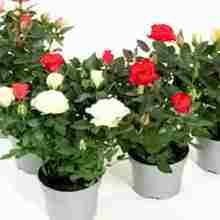Content
- 1 How to grow lavender at home
- 2 Reproduction methods
- 3 Self-picking lavender seeds and choosing them for sowing
- 4 Pretreatment of lavender seeds
- 5 Sowing lavender in the ground
- 6 Soil and containers for sowing lavender seeds for seedlings
- 7 Sowing lavender seeds for seedlings
- 8 Conditions for seed germination
- 9 Growing plants
- 10 Diving seedlings and caring for young lavenders
- 11 Hardening lavender seedlings
- 12 Planting lavender seedlings
- 13 Types of lavender for growing at home
- 14 Growing lavender from seeds
- 15 Growing lavender from cuttings
- 16 Diseases and pests
- 17 Harvesting
- 18 Remember what?
- 19 Preparation for growing
- 20 How to grow lavender
- 21 Where to place lavender
- 22 How to water and feed
- 23 Lavender in winter and possible problems
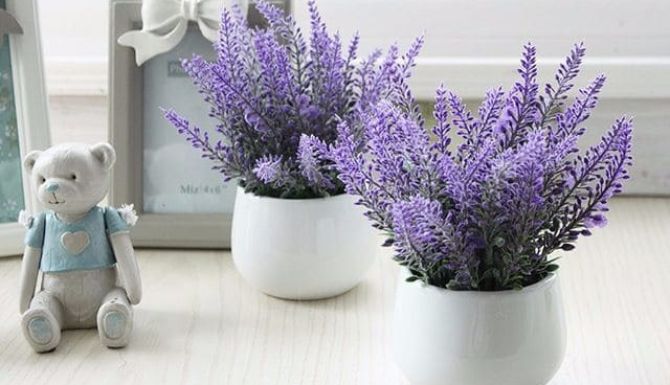
Lavender is a perennial essential oil crop, a semi-shrub. It is famous not only for its subtle Relaxing scent, which is not tolerated by moths and mosquitoes, but also for its medicinal properties. Her homeland is located on the shores of the Mediterranean Sea, therefore the plant is quite thermophilic.
Although this useful and beautiful flower is finicky and problematic to grow, it is possible at home in a pot. For good growth of room lavender, it is enough to take into account some subtleties and apply little effort. And these delicate flowers will adorn any balcony or loggia windowsill. Indoor specimens are much smaller than street varieties, but no less decorative.
How to grow lavender at home
For regions where the winter temperature drops below -15 ° C, it is necessary to take care of the safety of the roots, because there are no frosts in the homeland of a flower. The right solution would be to grow the bushes in ceramic pots or other suitable containers so that you can quickly hide them from frost. In winter, lavender shoots will do well at home in a pot on sunny windowsills.
Before growing lavender at home, you need to decide on the variety. When choosing one of the many types, it is necessary to take into account the climatic conditions of the area. French varieties are very thermophilic, while England and Portugal offer more resistant varieties.
The most important attribute when planting is the capacity in which the bush will grow. It should be deep and wide, at least 2 liters in volume and approximately 30 cm in diameter. After all, the root system of lavender has a large mass.
For the exuberant flowering of home lavender bushes, compliance with the basic rules of cultivation is required:
- Loosening the soil once a week to ensure the flow of oxygen to the rhizome.
- Laying a layer of mulch on top will help to maintain the moisture content of the substrate. For this, needles, sawdust or a store decorative substrate are suitable. The lower parts of the stems must be left open, otherwise mold or mildew may attack them due to the high humidity.
- To form a lush and beautiful bush, pruning excess, dry and weakened stems will help. Lavender can also be decorated in the bonsai style, because it is obedient and shoots grow well in any direction.
- With the onset of winter, pruning of dried stems is carried out. In severe frosts, the plants are covered or brought from the balcony (veranda) into the room.
- To feed and fertilize the bushes, it is suitable to use, according to the instructions, any complex mineral preparation for ornamental plants (with the exception of violets). But at the same time, fertilizers should not contain organic matter and nitrogen.To accelerate the growth and build-up of green mass, the introduction of potassium-containing dressings will help. Top dressing is applied to the root areas during the flowering period.
- In the second half of July, feeding should be stopped, so the flowers can rest and successfully prepare for winter.
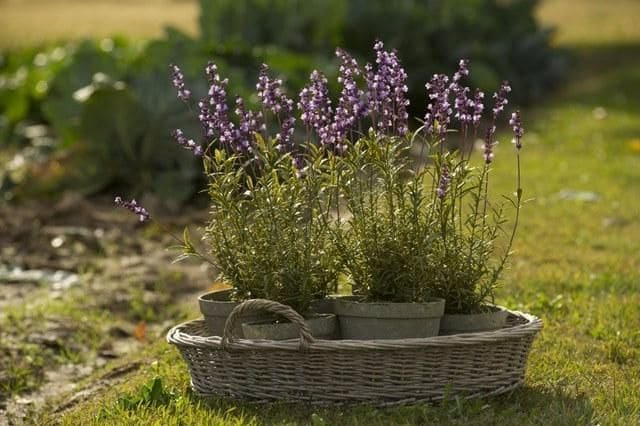
Reproduction methods
Lavender propagates by cuttings, cuttings, dividing the bush or seeds. Its layers are able to quickly take root and in the same year they will delight with delicate fragrant flowers. Growing from seeds is more time consuming, but it makes it possible to choose any of the varieties that are commercially available.
Propagation using seeds
After sowing, the first shoots appear in 50-55 days. With a great desire to grow one of the exotic whimsical varieties, strict adherence to all important stages of preparation and sowing is necessary:
- Seeds need to be stratified, for this they are kept in a cold place for at least 45 days. You can fill in the seed material with clean river sand, wrap it in a strong bag and store it on the lower shelf of the refrigerator. Cold hardening provides friendly seedlings, because it creates a feeling of natural conditions for the development of plants.
- Light and soft sandy soils with good fertilization are suitable for sowing. In this case, the seeds are buried no more than 3 cm. Clay soil is categorically unsuitable. The most optimal soil mixture is as follows: 3 parts of deciduous soil, part of sand and two parts of humus. The addition of lime helps create ideal growing conditions.
- The appearance of the first shoots should be expected no earlier than 30 days. Normal growth should take place at a temperature of about + 15- + 20 ° C and sufficient lighting with the presence of sunlight. It is better to place containers with seedlings on the windowsill of a well-lit south or east window. Penumbra causes the shoots to reach for the light, resulting in weak, tall stems.
- Lavender does not tolerate strong waterlogging and. Good drainage is essential for stable growth in a container. For this purpose, pebbles, expanded clay, nutshells are used, and the bottom is strewn with shards or fine gravel. In this case, you need to ensure that the drainage does not block the drain holes in the bottom of the container.
- To bring the emergence of seedlings closer, the pots are placed under glass or foil. At the same time, it is important to ventilate twice a day.
- When the shoots grow 5 cm and form a strong, healthy horse system, it is time to transplant them into permanent growing containers. Seedlings are planted at a distance of 10 cm from each other, this is a suitable option for home growing.
- Now it is better to be patient, because in the first year of life the plants are busy forming the root system and are gaining strength. Lavender flowers will delight you with the appearance after a year, or maybe a year and a half.
Now all that is needed is simple maintenance, which consists in maintaining the moisture content of the substrate at a suitable level and regular loosening.
Dividing the bush
For successful reproduction by dividing the bush, some preparation is required. In the autumn, the plant is pruned at a height of 8-10 cm and sprinkled with soil. With the arrival of spring, lavender is sprinkled again. These actions lead to the formation of numerous shoots. With the arrival of a new autumn, the bushes will be completely ready for separation.
When multiplying by division, flowering comes earlier than when using other methods. Adult bushes are carefully dug up and divided into separate parts. Before planting new plants in the ground, the root lobes are cut off so that they receive more moisture from the soil. At home, this breeding method is the most convenient.
When the bushes gain strength and give the first inflorescences, you can try to propagate by layering.
Reproduction using layering
This is a very convenient and time-consuming method.Next to the bushes, grooves are made into which some of the lower stems are bent, fixed in this position and sprinkled with a substrate. Plants will take root in these places. Already next spring the cuttings are suitable for independent growth. They are cut off from the bush, dug up and transplanted.
Potted lavender looks very beautiful and unusual. Although it is not much more difficult to grow bushes at home and take care of it than in the open field. The main condition is the purchase of quality seeds or seedlings. Poor quality seed may simply not sprout. And for good growth, it is important to observe the temperature regime and carefully look after. If it is important to get a plant of a certain variety, then for complete confidence it is better to purchase already flowering bushes. And if you apply diligence and patience, the house will always be filled with the alluring aroma of excellent flowering bushes.
Lavender is one of the indispensable perennials that is considered both luxurious and versatile at the same time. Despite its Mediterranean origin, lavender has long taken root in our country. And although only one species can boast of sufficient winter hardiness, it is impossible to imagine a single modern garden without lavender. But the popularity had little effect on the rather high price of planting material, because of which more and more gardeners decide to grow a plant on their own. The most affordable way - growing lavender from seeds - is not quite rightly called and the most difficult.
Lavender during flowering
Lavender (Lavandula) in the middle lane and to the north is represented by only one frost-hardy species - English lavender, or narrow-leaved lavender (Lavandula angustifolia). It is a perennial shrub with numerous woody shoots in the lower part, densely covered with opposite, sessile silvery-grayish leaves. Small blue or lilac lavender flowers are collected in whorls in slender spikelets of inflorescences crowning leafless shoots. Fragrant, bright, textured, unusually elegant, lavender is recognizable at first sight. English lavender traditionally blooms in mid to late summer.
In reproduction, both narrow-leaved and other types of lavender are almost the same. Regardless of the degree of winter hardiness, representatives of the genus Lavandula retain common features and differ only in details - in the size of leaves and flowers. Without exception, all lavenders are easiest to propagate vegetatively.: Plants give a large number of shoots, and cuttings and cuttings root well in them. But in this way you can only get lavender of the variety and type that you already have or are on the market (and rare varieties with an interesting color and unusual species, as a rule, are rare). And the number of "offspring" will always be more or less limited. If you want to grow a new variety of lavender and get a large number of seedlings, significantly saving both time and money, then you can use the less popular, notoriously difficult, method - to grow lavender from seeds. In practice, seed propagation of lavender is not at all tricky, since the only difficulty - stratification - is overcome quite simply.
Self-picking lavender seeds and choosing them for sowing
When choosing lavender seeds, pay special attention to price and manufacturer. Buy lavender only from trusted companies and suppliers you trust, with a wide palette of ornamental plants and a representative collection of not only summer seeds, but also other perennials. Remember that lavender seeds cannot be readily available: cheap seeds can be unpleasantly surprised by “substituting” one type for another. Make sure that information about the manufacturer, plant characteristics, planting characteristics is presented in full.
You can also collect the seeds yourself, by buying or collecting fully blossoming inflorescences, making bouquets of lavender and, after drying, preserving the small and fragrant seeds that have spilled out.
Lavender seeds remain viable for an astonishingly long time. It is not at all necessary to use them fresh, even after 5 years they will grow together, subject to all the rules of agricultural technology. And the main condition is proper storage of seeds: they must be kept in hermetically sealed containers.
Pretreatment of lavender seeds
Lavender seeds need stratification, or rather cold stratification. Without cold treatment, they will not rise, and the effect of low temperatures should continue for a long time. Depending on the method and timing of processing, there are two options for growing lavender from seeds:
- Artificial stratification, cold exposure before sowing.
- Natural stratification, sowing before winter to pass the cooling period already in the soil.
The minimum period for stratification of lavender seeds is 1.5 months (or at least 30-40 days). If stratification lasts longer, this will only have a positive effect on the number of seedlings and the rate of germination.
Artificial stratification it is better to carry out not in bags, but by mixing lavender seeds with sand or substrate. After filling the container with the prepared mixture, it is wrapped with foil or covered with a lid (you can also fill hermetically sealed plastic bags with the mixture). The seeds are sent for cooling for 6-8 weeks at a temperature of about 5 degrees Celsius. There is no need to freeze lavender seeds: they just need to be placed in the refrigerator to pass through the cooling phase.
In addition to the usual stratification, you can experiment with other processing methods:
- scalding lavender seeds sown in the ground;
- treatment with a growth stimulant or phytohormones (for example, gibberellin at a concentration of 100 to 200 ml per 1 liter of water).
But such methods may not work at all.
Sowing lavender in the ground
Sowing lavender before winter is not a difficult task and differs little from growing any perennial and annual plant that prefer stratification. Sowing is carried out at the end of October, trying not to bury the seeds too much in the soil and be sure to mulch the ridge for protection for the winter. You should not be afraid that lavender does not sprout in early spring: the plant will release the first shoots no earlier than May, or even on the eve of summer, when temperatures will rise significantly at night.
Sowing in the soil in spring is carried out in May.when the threat of strong returnable frosts disappears. In this case, the seeds are subjected to artificial stratification.
Seed-grown lavender seedlings
Soil and containers for sowing lavender seeds for seedlings
For lavender, universal loose substrates with a high proportion of nutritional value are used. For this plant, it is preferable to use ready-made soil mixtures (universal for indoor plants or special for seedlings and summer plants). Before planting, it is advisable to ignite or spill the substrate with potassium permanganate.
When choosing containers for sowing lavender for seedlings, you should give preference to shallow, but large and wide containers, boxes and bowls. Lavender is not sown in cassettes. The maximum depth of the container is 7 cm.
Sowing lavender seeds for seedlings
Sowing for seedlings is carried out at the end of winter, in the second half of February or the first half of March.... It is customary to sow lavender in large boxes quite rarely, laying out the seeds literally one at a time, because despite the fact that the plants are not afraid of transplants, they have powerful roots and primarily grow long roots, which are easy to damage with dense sowing. The rest of the landing rules are quite simple:
- The containers are filled with soil and carefully, without tamping, level it.
- The soil is moistened from above with a spray bottle.
- Lavender seeds are planted one at a time at a distance of 1.5-2 cm.
- Cover from above with 2 - 3 mm of soil (preferably sifted), without deepening deep.
- Immediately after sowing, the containers are covered with glass or foil.
Conditions for seed germination
For lavender, there are two main factors to ensure:
- bright lighting;
- restrained room temperature in the range from 15 to 21 degrees Celsius.
During the entire period before the emergence of lavender shoots, it is necessary to maintain a light but stable soil moisture, carefully spraying the soil in the morning and airing the "greenhouses". Waterlogging is very dangerous, but without constant, at least light humidity, it will be difficult to achieve friendly shoots.
Lavender usually takes a long time to germinate. The first shoots can appear in 2 weeks, friendly shoots - on average, after 1 month.
Growing plants
After the emergence of friendly shoots of lavender, glass or film is removed from the containers as soon as possible, but they continue to maintain a slight moisture content in the soil. Young shoots should be placed in the brightest place (preferably on a sunny southern windowsill). If there is not enough sunlight, lavender is supplemented with light, increasing daylight hours to 8-10 hours.
Transplanted lavender seedling grown from seed
Diving seedlings and caring for young lavenders
Lavender dives only when the plant forms one pair of true leaves and the third or fourth full-fledged leaf begins to develop... As a rule, even young seedlings of lavender first of all grow roots, and at this stage, rather powerful roots are formed, which will not have enough space in a shallow bowl.
Lavender is transplanted carefully, but this procedure is easily tolerated by the plants. It is advisable to dive into individual pots or cups with a diameter of 5-6 cm, but large boxes can also be used, leaving a similar distance between the plants. For lavender seedlings, you can use a peat-sand mixture or a lighter substrate for indoor plants with the addition of perlite and sand. Long-term fertilizers can be added to the soil.
Lavender is transferred to new containers, trying not to destroy the earthen ball, carefully crumbling the ground around the seedlings to speed up rooting.
Hardening lavender seedlings
Lavender seedlings will need to be hardened for at least 1 week to adapt to new conditions. Plants are taken out gradually, starting at 1 hour per day and increasing the time spent outdoors every day.
Planting lavender seedlings
Lavender grown from seeds blooms only the next year after germination. For the entire first year, the plant does not develop very rapidly: first, lavender grows roots, and only then shoots. But on the other hand, well-rooted plants develop very quickly in the second year and delight with their fragrant inflorescences.
For planting lavender seedlings, they choose sunny places with light soil, to which organic fertilizers have been added. Stony, sandy-clayey soils are more suitable for this perennial. The optimum pH for this plant is 6.5 to 7.5. For planting, it is better to prepare a special soil mixture by mixing the soil removed from the planting hole with sand, humus and mineral fertilizers or completely replacing the soil with a mixture of leafy soil, sand and humus in a ratio of 3: 1: 2.
The distance when planting lavender is from 30 to 40 cm.This plant is planted in individual, rather large planting holes with a depth and diameter of about 30 cm.
Lavender will gratefully respond not only to abundant watering, but also to mulching immediately after planting (it is advisable to keep the mulch layer constant, but never bring it directly under the base of the bushes).
Seed-Transplanted Lavender Bush
In the first year after planting seedlings or sowing in the ground, despite all its drought resistance, it is advisable for lavender to provide regular watering. Watering is carried out only in drought.But weeding and protection from weeds are needed in the first year regular. In the first year of flowering, you should not let the lavender bloom violently and, even more so, form seeds: it is advisable to cut off the inflorescences as soon as the first flowers bloom. In the second year of flowering, the inflorescences are cut off as soon as a third of the flowers open and leaving about a third of all inflorescences on the plant. In subsequent years, such tricks will not be needed.
In the first wintering in the soil, it is advisable to protect lavender grown from seeds with an additional high layer of mulch from dry leaves or spruce branches.
Alternative breeding methods for lavender:
- separation of bushes (planting overgrowth);
- rooting of cuttings;
- cuttings of annual shoots.
In the article, we discuss lavender at home, what types of plants to use for planting, how to properly prepare the soil and take care of the plant. You will learn how to use essential oil medicinally and harvest lavender.
Types of lavender for growing at home
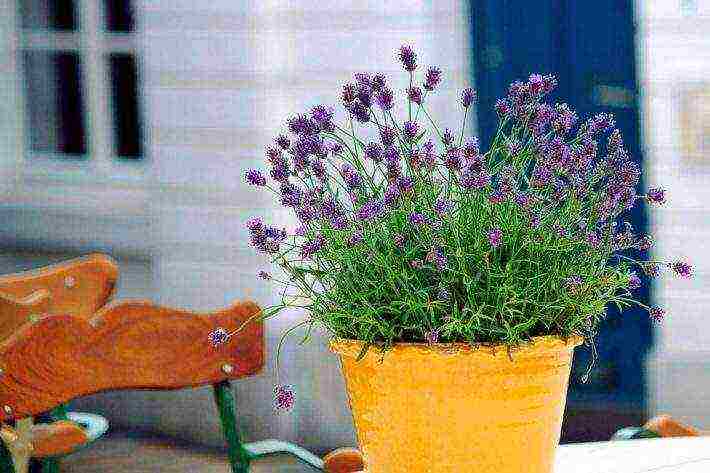 Lavender can be grown not only on a personal plot, but also at home.
Lavender can be grown not only on a personal plot, but also at home.
Before growing lavender at home, you need to know which species are suitable for indoor conditions. Narrow-leaved and broad-leaved lavender are suitable for this. Narrow-leaved is also called English, and broadleaf - Mediterranean.
Lavender requires abundant watering, adequate lighting, and good drainage.
Indoor lavender is used to calm the nervous system and improve sleep quality. Medicinal decoctions are prepared from the stems and flowers.
Growing lavender from seeds
Good growth of lavender at home is due to the preparation of a suitable substrate, the choice of a container for planting the right volume and the provision of quality care. If these requirements are met, a bountiful harvest can be harvested by the end of summer.
Soil preparation
To grow lavender at home, start by choosing a container or pot.... Regardless of how the plant will be grown - by dividing cuttings or using seeds - use dishes with a capacity of at least 2 liters. To grow lavender at home in a pot, pebbles and gravel are placed on the bottom. The substrate is prepared from a sand-peat mixture taken in a 1: 1 ratio. Add 1 part of perlite and crushed shells from 2 eggs.
Landing
Care and cultivation of lavender at home is not a hassle if the seeds have been stratified. To do this, the seeds are mixed with sawdust or sand and placed in the refrigerator for 30 days. Hardening improves germination rates and makes the plant more adaptable to temperature extremes. In alkaline soil, they give excellent yields.
The seeds are planted in the substrate to a depth of about 3 mm. The container is covered with plastic wrap and placed in a cool, well-lit place. Only one of 15-20 seeds can sprout, so the seeds are hardened and planted in large quantities. When there are more than six pairs of leaves on the sprout, pinch off its top, this is necessary for the lavender to bush better.
Care
The plant should be exposed to sunlight for at least 10 hours a day. If the pots are on the windowsill, the heat from the battery makes the air dry and hot - this negatively affects the growth of lavender. Therefore, next to the heating devices, containers with water or air conditioners are placed, in which the humidification function is provided.
Home care for lavender begins with daily watering of the plant. The soil should not dry out. It is necessary to ensure that it is always slightly damp. Water the plant once a day in the early morning or in the evening. The first 3-4 weeks add 2 g of fertilizer to 1 liter of water.
But you can't pour lavender with water either - its roots rot. Before growing lavender at home, make 2-3 small holes in the bottom of the pot or container and place the container on a pallet - this ensures the timely outflow of excess water and moisten the lower layers of the soil as it dries.
Planting and caring for lavender at home does not mean that the plant should always stand on the windowsill. In springtime, it is taken out on the balcony for a few minutes and brought home again. Gradually the time of these "walks" is increased to several hours.
Caring for potted lavender at home also includes choosing its location. The plant does not like drafts and cold winds, but it grows well on the south side of the dwelling. If there are many sprouts, and they are crowded into a dense mass, then they should be divided into identical heaps. To do this, the lower parts of the plant are slightly pushed apart and mark the boundaries, pouring soil into the formed depressions.
Lavender “falls asleep” at home in winter, so it must be removed from the sunny side to the cool part of the room. At this time, it does not grow and is watered much less often - as the soil dries up.
Lavender grows well at home only in loose, light soil. In black soil and clay soil, it will die.
Growing lavender from cuttings
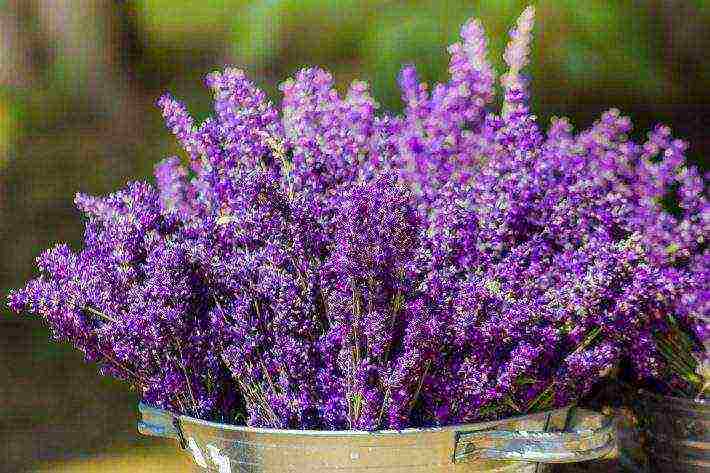 Plant lavender by seed or cuttings
Plant lavender by seed or cuttings
When properly grown in a pot at home, lavender becomes lush and fills rooms with a pleasant scent. Space in the pot is limited, so the roots, over time, entwine the entire lump of soil and dry quickly. The plant requires timely transplantation into a larger container. If there is a need for lavender propagation, use the cuttings method.
Use cuttings propagation during the autumn pruning of the plant, when it is being prepared for hibernation. To do this, choose annual shoots that are already covered with bark. Make the lower cuts of the cuttings closer to the buds - this will avoid further rotting of the plant in the soil. For propagation, use branches in the middle zone of the bush.
The cuttings are 7-10 cm long. They are dipped into a moistened sand-peat mixture and covered with foil or film. Water them as the substrate dries, while spraying the above-ground part of the plant. In the daytime, free the cutting from the protective coating for 1-2 hours and let the plant "breathe".
How to grow lavender in a pot at home with layering? In this case, cuttings are formed from plant shoots, which are pressed against the ground with a load. When they put out the roots, the cuttings are cut off and planted separately.
Diseases and pests
Home care for lavender includes pest control that can cause the plant to die without ever producing a crop. The main enemies of the plant are gray rot and pennies. In the first case, dark spots appear on the leaves. They move to healthy areas of lavender and quickly destroy the plant. The main way to deal with them is the timely removal of the affected areas.
Pennits gnaw the leaves, forming large holes in them. Insects lay the larvae by covering them with a substance similar to frothy saliva. Thus, they protect the offspring from the attack of other pests. The foam can be washed off with a stream of water, but the pennies themselves must be collected by hand. When treated with toxic substances, you risk killing the lavender.
For more information on planting lavender, see the video:
Harvesting
Growing lavender properly in a pot at the end of summer will yield a bountiful harvest. The cups of the plant are used to prepare medicinal decoctions - they contain the largest amount of useful substances. Wait for the moment when the plant wilts, and the area of dried petals will be equal to about ⅔ of the total number of flowers.
For storage for the winter, collect the plant in small bunches. Tie them with a thick thread and hang them in a dry ventilated area (pantry, roof). Once the lavender is dry, place it in canvas bags or chop it and put it in a glass container. In this form, the plant retains its beneficial properties until the next harvest.
Remember what?
- Can lavender be grown at home? Successful plant breeding depends on proper care and the types of lavender you use. For indoor conditions, narrow-leaved and broad-leaved species are suitable.
- How to care for lavender at home, depending on the season? Water it every day in the summer, and as the soil dries up in the winter.
- If growing lavender from seed, use stratification.
- The calyx of the plant contains the largest amount of lavender oil.
- Use lavender to treat nervous disorders, depression and insomnia.
Lavender is a beautiful plant with a strong and pleasant scent that can be a decoration for any garden. It is also possible to grow this flower at home, including from seeds. But if in the open ground there is practically no need for care - it is enough to choose a suitable place - then you will have to make an effort at home. But the result is sure to please. In addition, the plant has medicinal properties, so it can be grown for more than just beauty.
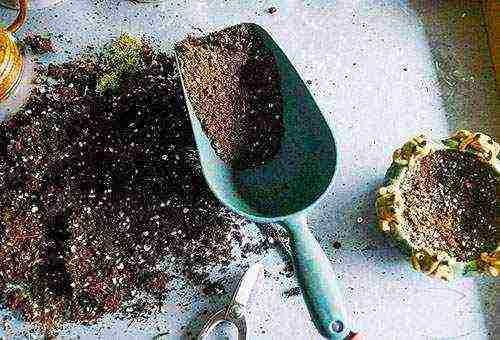
Preparation for growing
There is more than one type of plant. At home, French broadleaf lavender grows best. If the care is sufficient, then flowering will last from May to August.
You can grow lavender from seeds or using cuttings and cuttings. Whichever method is used, you should start with the preparation of the soil. Simple earth is not suitable for this: it does not have enough nutrients, so it will not be able to ensure the normal development of the plant.
Therefore, it is necessary to make a special soil mixture. Alkaline is best. To do this, mix peat, sand and gravel or crushed eggshells. Another option: sand, humus and leafy earth are combined in a ratio of 1: 2: 3.
It is also important to prepare suitable containers. The plant has a peculiarity - a long root that grows quickly. And when he runs into any obstacle, the growth stops. At the same time, the bush itself stops developing. If buds have already appeared on it, then they will dry out and flowering will not take place. A transplant will not help in this case - you will have to wait for the next season. Therefore, one of the most important secrets of growing lavender at home is choosing a large enough container. Its diameter should be about 30 cm, and its volume should be 2 liters.
Good air circulation is important for the plant. Therefore, in the future, it will be necessary to regularly loosen the ground. And before planting is carried out, you should take care of good drainage. To do this, small objects are placed in the pot: pebbles, shards, even a nutshell. But you must make sure that the holes in the bottom of the container remain free.
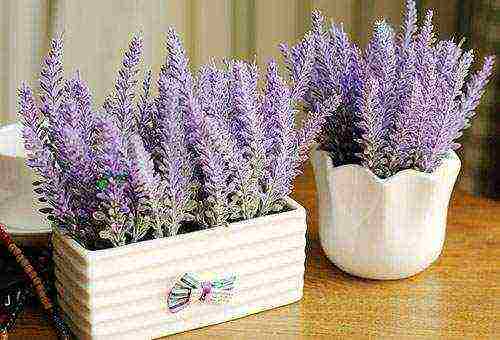
How to grow lavender
Growing from seeds is considered a rather laborious process. But this method is used often, because it is usually easier to get seeds than cuttings. The main difficulty is that at home they have to be stratified, otherwise they are unlikely to germinate. That is, they need to provide conditions similar to natural ones. To do this, they are placed in a container with layers of sand and sawdust and left for a month. The temperature should be 5 degrees.
The best time to start growing from seed at home is November. After the end of the stratification period, you can sow them in containers filled with soil mixture. The depth should not be great, 3 mm is enough. Then the container must be placed in a corner that is very well lit. Temperature also matters: it can range from 15 to 21 degrees. The container should be covered with plastic wrap and raised from time to time for airing.
If all the conditions are met, then after 30 days the first shoots will be noticeable. In rare cases, this does not happen. When containers can be refrigerated for 3 weeks. As soon as germination begins, the container must be taken from there, and the sprouts must be planted in separate containers.
Growing from cuttings is considered easier than growing from seeds. The difficulty lies in the fact that this method requires acquaintances who are engaged in lavender cultivation. To obtain cuttings suitable for propagation, annual shoots are used. They are divided into 10 cm pieces, then they are placed in well-moistened soil and covered with a bag or jar. It is worth planting more than intended, since there is no guarantee that all of them will take root.
It is not difficult to obtain cuttings suitable for plant propagation. To do this, you just need to select a young twig and press it to the ground, digging a little. After a while, it will give roots. Again, this method requires an adult lavender bush.

Where to place lavender
Further care includes choosing a suitable place. Remember that lavender loves sunlight. And if in the open ground it is able to grow even in the shade without compromising its qualities, then at home the sun is vital for it. It does not matter whether the bushes are obtained from the seeds or not. Therefore, it is recommended to place the potted plant on the east or west windowsill. If the lighting is poor, then a fluorescent lamp should be used. You also need to take care of regular airing, only in this case it is worth making sure that the flower does not stand in a draft.
But the humidity of the house is practically irrelevant. Only if the flowerpot is close to the battery, then it is advisable to put a container of water next to it or often spray lavender. But it is better to avoid such places.
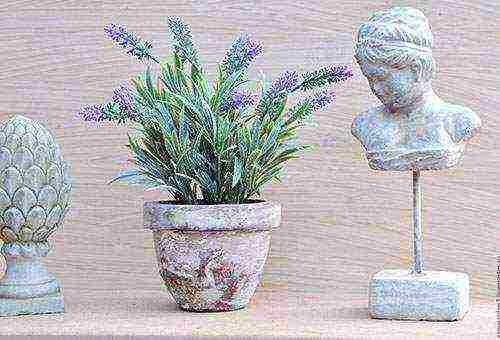
How to water and feed
It is unlikely that it will be possible to imagine caring for a plant without regular watering and feeding. The soil should be slightly damp all the time. During the first 30 days from the moment the sprouts appear, watering is carried out twice a day. Then you need to do this less often.
Overflow for a flower can be disastrous. Especially with a lack of light, then even drainage will not have the desired effect. The plant will begin to stretch excessively, and instead of silvery leaves, green leaves will begin to appear, which cannot withstand direct sunlight. Because of this, they weaken and hang down. If such signs appear, then one should not think that the flower does not have enough moisture. You should check the amount of water that the plant is receiving and whether there is sufficient lighting. After all, it accumulates moisture only in thick grayish leaves.
If lavender is grown at home, then you need to take care of fertilization. It is especially important in the first two months after germination from seeds. Top dressing is carried out every week by dissolving 2 g of special fertilizer in a liter of water. After the end of this period, feeding is resumed only during the flowering period. After it, all fertilizers should be canceled so that the flower can prepare for winter.
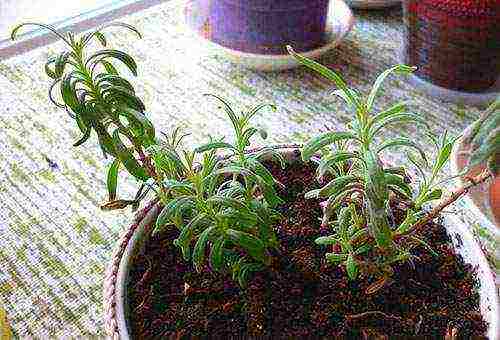
Lavender in winter and possible problems
Although lavender at home stays green all year round, it still has a rest period in winter. Therefore, care should include preparation for the winter period. To do this, after flowering is over, the lavender is cut at a level slightly above the beginning of the growth of the leaves. Dry shoots should be removed.
The potted plant must be moved to a cool place away from heating appliances. Watering should be reduced for this time, once a week is enough. It happens that flowering continues in winter. But this will negatively affect the bush. Therefore, in the spring, all growths must be removed, you can also transplant into another pot.
Advice
If pests, such as leafhoppers, are nevertheless noticed on homemade lavender, then it will need to be treated with Furosemide.
If you provide proper care, then there will be no special problems when growing lavender at home. Pests practically do not bother her, moreover, she is able to scare away insects from other plants.
The main thing to watch out for is that there is no overflow. Because of it, the leaves can turn yellow and the roots rot.The flower is drought-resistant enough, so there is no need to be afraid that it will not have enough moisture.
At home, weeds are practically not scary. But if they suddenly start to appear, then they need to be removed.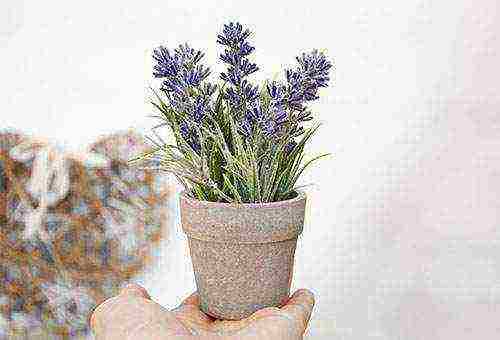
If you want to decorate the windowsills with an unusual plant for your home, then it's time to grow lavender. This can be done using seeds. Its delicate lilac flowers will become a real decoration, and a delicate aroma will give the room a special atmosphere.
Of course, in order to get the desired result, you will have to learn how to properly care. Timely planting, watering and feeding are necessary. But in the future, you can not only admire the plant, but also use its healing qualities.
